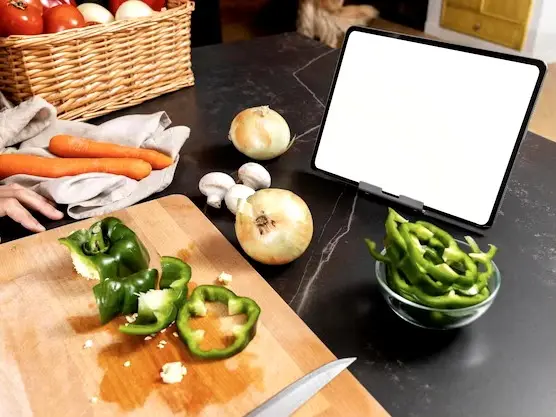- Transformative smart kitchen technologies: The article highlights how smart ovens, fridges, and automated cooking systems are revolutionizing kitchen efficiency. These appliances use AI to optimize cooking and offer features like real-time inventory tracking, enhancing convenience and reducing food waste.
- Enhanced user experience and health focus: Smart lighting, thermostats, and health-focused devices like smart scales help create a personalized kitchen environment. These technologies promote wellness by offering tailored meal suggestions and ensuring precise ingredient measurements, making the kitchen a hub for healthier living.
Imagine stepping into your kitchen after a long day at work. With a simple voice command, the lights brighten to your desired warmth, the oven begins preheating to the exact temperature for tonight’s dinner, and your fridge sends a notification reminding you that you’re low on milk and need more eggs. As you start chopping vegetables, your smart scale measures out the exact amount of ingredients for your recipe, syncing with your phone to ensure perfect precision every time.
This is no longer the future—it’s happening right now. Welcome to the smart kitchen, the heart of the modern smart home revolution. Once limited to sci-fi movies, the integration of IoT (Internet of Things) devices into kitchens has completely transformed how we cook, shop, and manage daily life. According to a report by Statista, the smart home market is expected to grow to over $53 billion by 2025, with smart kitchen appliances playing a key role in this surge.
However, many kitchens are still stuck in the past, using outdated appliances and manual processes. This feature explores how innovative technology is reshaping the kitchen and why it’s time to consider upgrading your cooking space.
Also read: 7 ways tech has changed how we eat

1. Smart appliances: Redefining kitchen efficiency
One of the most significant changes in the kitchen today is the advent of smart appliances. These high-tech devices are more than just gadgets—they are designed to make cooking more convenient, efficient, and enjoyable.
One of the most significant changes in the kitchen today is the advent of smart appliances. These high-tech devices are more than just gadgets—they are designed to make cooking more convenient, efficient, and enjoyable.
- Smart Ovens and Ranges: Gone are the days when you had to adjust the oven manually or check the temperature every few minutes. With smart ovens like June Oven and Tovala, you can simply input your recipe or let the appliance recognize the food you place inside. These devices use AI to adjust cooking settings, ensuring perfect results with minimal effort.
- Smart Refrigerators: The Samsung Family Hub and LG’s InstaView refrigerators are revolutionizing how we interact with our food. These fridges let you view what’s inside through cameras and manage your grocery list directly from the touchscreen. The Family Hub, for example, allows you to shop directly from the fridge, saving you time and energy.
- Voice-Controlled Cooking: With voice assistants like Amazon Alexa, Google Assistant, and Siri, smart kitchens now allow users to control their appliances hands-free. You can set the oven’s temperature, turn on lights, or start your coffee machine simply by speaking commands. This level of control not only adds convenience but also makes the kitchen more accessible for everyone in the family.

2. Automating the cooking process: Saving time and effort
The rise of automated cooking devices has significantly reduced the time and effort required to prepare meals. These devices allow people to set up a meal, walk away, and come back to a perfectly cooked dish.
- Robot Chefs: Mark Oleynik, CEO of Moley Robotics, has been vocal about the potential of robotic chefs, stating, “The aim is to revolutionize the cooking experience at home, making high-quality meals accessible with the press of a button.” This ambition aligns with Moley’s creation of fully automated kitchen systems capable of mimicking the precise movements of professional chefs, from chopping to plating.
- Sous-Vide Technology: David McInerney, CEO of Anova Culinary, noted the rise of sous-vide technology in home kitchens, saying, “The precision and consistency of sous-vide cooking have democratized fine dining, bringing restaurant-quality results to the everyday cook.” This technology has become a staple for cooking enthusiasts who want to ensure perfectly cooked meals every time, offering precise temperature control to elevate home-cooked dishes.
“The aim is to revolutionize the cooking experience at home, making high-quality meals accessible with the press of a button.”
Mark Oleynik, CEO of Moley Robotics3. Inventory management: Never run out of essentials again
Managing kitchen inventory is a headache for many people—until now. With smart fridges, pantry systems, and connected apps, it’s easier than ever to keep track of groceries and reduce waste.
- Smart Fridges: Smart refrigerators now come with features like barcode scanning and automatic inventory tracking. With a built-in camera, you can view what’s inside your fridge from your smartphone, and apps will notify you when items are running low or nearing expiration. For example, the Samsung Family Hub allows users to check fridge contents while shopping or while on the go, eliminating the need to open the door and rummage through it.
- Connected Pantry Systems: Connected pantry systems are also becoming popular, helping homeowners track their stock of pantry items, grains, and canned goods. Services like Amazon Dash allow you to reorder items automatically once they run low, saving you time and preventing unnecessary trips to the store.
- Waste Reduction: By tracking expiry dates and inventory levels, smart kitchens can help reduce food waste. This not only saves money but also supports sustainability efforts by ensuring food is consumed before it goes bad.
Also read: Samsung Introduces Diet Platform: Samsung Food

4. The power of smart lighting and temperature control
Lighting and temperature control are essential aspects of creating the right atmosphere in your kitchen. With smart lighting and thermostats, you can easily adjust settings to suit your needs—whether you’re cooking, dining, or entertaining.
- Smart Lighting: Devices like Philips Hue and LIFX allow you to adjust the color and brightness of your kitchen lights. Whether you need bright, focused light for meal prep or a softer glow for dining, smart lights give you full control. Voice assistants can also adjust your kitchen’s lighting, ensuring you never have to reach for a switch again.
- Smart Thermostats: Nest and Ecobee thermostats are not only perfect for controlling the temperature in your home, but they can also be used to optimize your kitchen environment. Matt Rogers, co-founder of Nest, remarked on the value of smart learning in thermostats: “Our goal was to create a thermostat that can program itself, saving you time and energy. It learns from your preferences and makes adjustments automatically.” These thermostats learn your preferences over time and adjust the temperature accordingly, ensuring comfort while also saving energy.
“Our goal was to create a thermostat that can program itself, saving you time and energy. It learns from your preferences and makes adjustments automatically.”
Matt Rogers, co-founder of Nest5. Health and nutrition: Cooking for wellness
The modern kitchen isn’t just about convenience—it’s also about promoting better health. Smart kitchen devices now provide support for users who want to eat healthier, track nutritional intake, and meet their fitness goals.
- Smart Scales: Devices like the Perfect Bake Scale sync with apps to help you measure ingredients accurately, ensuring that your meals are both nutritious and properly portioned. These smart scales make it easier to follow recipes, track calories, and stay on top of dietary needs.
- Smart Cooking for Special Diets: For those following specialized diets like keto, vegan, or gluten-free, there are devices that provide personalized meal suggestions and help with meal prep. Platforms like Yummly integrate with smart kitchen devices to recommend recipes tailored to your dietary preferences and nutritional requirements.
Pop quiz
What is the main benefit of using a sous-vide cooker in your kitchen?
A. Faster cooking times
B. Precise temperature control for consistent results
C. Automated cleaning
D. Voice control for hands-free operation
The correct answer is at the bottom of the article.
Smart kitchen is reshaping our lives
The smart home revolution is already reshaping the way we live, and the kitchen is at the heart of this transformation. Smart appliances, automated cooking, inventory management, and connected features have made the kitchen more efficient, accessible, and enjoyable.
For many homeowners, the move to a smart kitchen isn’t just about upgrading appliances; it’s about improving the quality of life through enhanced convenience, healthier living, and sustainable practices. However, embracing this revolution requires more than just purchasing the latest gadgets—it’s about rethinking how we interact with food, manage daily routines, and optimize our environments.
If your kitchen isn’t yet fully integrated with smart technology, now is the time to start. From saving time and energy to reducing food waste and promoting healthier habits, the smart kitchen is no longer a luxury; it’s becoming a necessity. As technology continues to evolve, the future of the kitchen will be even more connected, intelligent, and user-centric. So, is your kitchen ready for the future? It’s time to find out.
Quiz answer
B. Precise temperature control for consistent results













)





 English (US) ·
English (US) ·